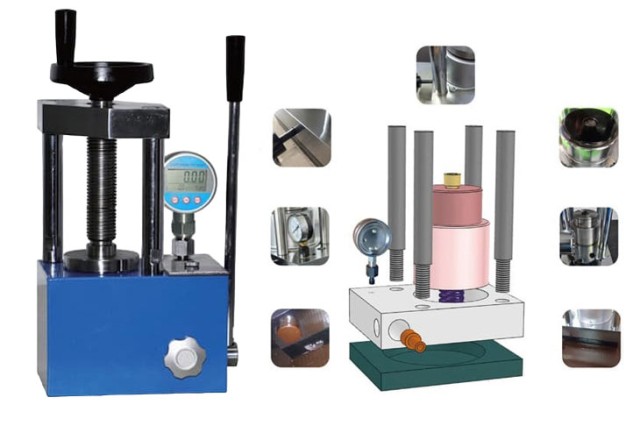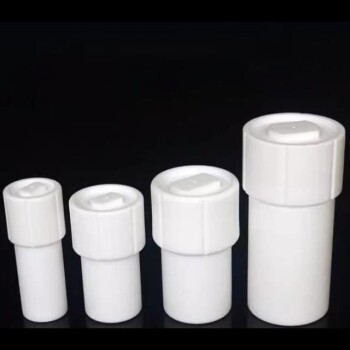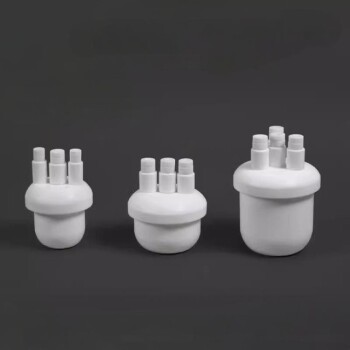Introduction to Manual Hydraulic Presses
Manual hydraulic presses are indispensable tools in laboratory settings, particularly for tasks such as preparing KBr pellets for FTIR and general sample pellets for XRF. These presses offer a reliable method for creating uniform, high-quality samples essential for accurate analysis. This guide delves into the intricacies of manual hydraulic presses, exploring their primary uses, key components, and the unique advantages they offer over automatic models. Whether you are a seasoned researcher or new to laboratory equipment, understanding the operation, maintenance, and benefits of manual hydraulic presses is crucial for efficient and effective sample preparation. Join us as we navigate through the practical aspects and innovations surrounding these vital laboratory instruments.
Components and Design of Manual Hydraulic Presses
Manual hydraulic presses are essential tools in various industrial applications, known for their simplicity and effectiveness in applying controlled pressure. These presses are composed of several key components, each playing a crucial role in the operation and efficiency of the machine. Understanding these components and their design variations is vital for selecting the right press for specific tasks.
Hydraulic Cylinder and Piston
At the core of a manual hydraulic press is the hydraulic cylinder, which houses the piston. The cylinder is typically made from robust materials like steel to withstand high pressures. The piston, a cylindrical component that moves within the cylinder, is responsible for applying force to the material placed on the press. The movement of the piston is facilitated by hydraulic fluid, which is pressurized by a hand-operated pump.
Hand-Operated Pump
The hand-operated pump is a manual mechanism that pressurizes the hydraulic fluid. This pump is connected to the hydraulic cylinder and, when operated, forces the fluid into the cylinder, causing the piston to move. The design of the pump can vary, but it generally includes a handle and a plunger. The operator controls the pressure and speed of the press by the rate at which they operate the pump.
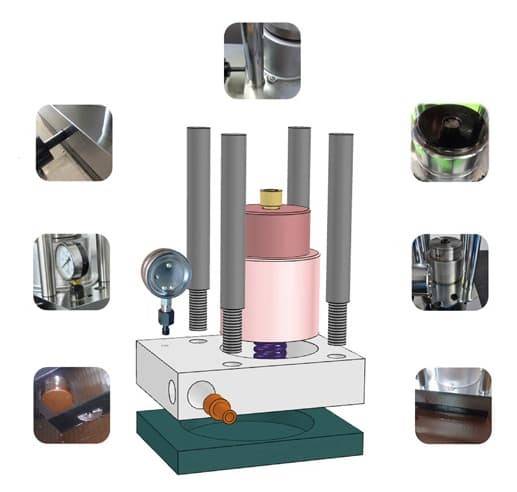
Pressure Gauge
A pressure gauge is a critical component of a manual hydraulic press. It provides real-time feedback on the pressure within the hydraulic system. This gauge helps the operator monitor and control the pressure applied to the workpiece, ensuring it stays within safe and effective limits. The accuracy of the pressure gauge is essential for maintaining the quality and consistency of the pressing operation.
Design Variations: Two-Column and Four-Column Presses
Manual hydraulic presses come in various designs, with two-column and four-column presses being the most common. Two-column presses, also known as C-frame presses, are characterized by their open design and two vertical support columns. This design offers flexibility and ease of access, making it suitable for tasks that require frequent loading and unloading of materials.
Four-column presses, on the other hand, feature four vertical support columns that provide greater stability and rigidity. This design is ideal for applications that require higher tonnage and more precise alignment. The four-column design also offers better load distribution, reducing the risk of deformation or misalignment during operation.
Additional Components
Other components of a manual hydraulic press include the oil tank, which stores the hydraulic fluid; the pressing plate, which applies pressure to the workpiece; and various valves and controls that regulate the flow and pressure of the hydraulic fluid. These components work in concert to ensure smooth and efficient operation of the press.
In conclusion, the components and design of manual hydraulic presses are meticulously engineered to provide reliable and controlled pressure for a wide range of industrial applications. Whether it's a two-column or four-column design, each component plays a vital role in the functionality and effectiveness of the press. Understanding these components and their interactions is essential for selecting the right press for specific tasks and ensuring optimal performance.
Advantages of Using Manual Hydraulic Presses
Manual hydraulic presses offer several advantages over their automatic counterparts, particularly in terms of cost-effectiveness, simplicity, and suitability for infrequent use. These benefits make manual presses an attractive option for many laboratories, especially those operating on a tight budget or with limited sample processing needs.
Cost-Effectiveness
One of the most significant advantages of manual hydraulic presses is their lower upfront cost. Unlike automatic presses, which require electronic components and motors, manual presses are generally more affordable. This cost difference can be substantial, especially for smaller labs or those just starting out. Additionally, manual presses do not require electricity to operate, which can lead to further cost savings over time.

Simplicity
Manual hydraulic presses are inherently simpler in design and operation compared to automatic models. They typically consist of a basic hydraulic mechanism that is manually operated, requiring no complex electronic controls or programming. This simplicity translates to easier maintenance and troubleshooting, reducing the likelihood of downtime and the need for specialized technical support.
Suitability for Infrequent Use
For laboratories that do not require frequent use of a hydraulic press, manual models are often the most practical choice. Automatic presses, while offering higher precision and efficiency, can be overkill for infrequent applications and may not justify their higher cost. Manual presses, on the other hand, can be easily brought into service when needed without the overhead of maintaining an automated system.
Case Studies and Examples
Several laboratories have found manual hydraulic presses to be highly beneficial in their operations. For instance, a small research lab focused on material science might use a manual press to create samples for initial testing. The infrequent nature of these tests makes a manual press a cost-effective and practical solution. Similarly, a university lab conducting occasional experiments on composite materials could benefit from the simplicity and lower cost of a manual press, ensuring that resources are allocated efficiently.
Efficiency in Low-Force Applications
Manual hydraulic presses are particularly efficient in low-force applications where repeatability is not a critical factor. For example, in the preparation of certain biological samples or in the initial stages of material testing, a manual press can apply the necessary force without the need for precise, repeatable pressure settings. This flexibility allows labs to adapt their processes as needed without the complexity of automated systems.
Conclusion
In summary, manual hydraulic presses offer a range of advantages that make them suitable for many laboratory environments. Their cost-effectiveness, simplicity, and suitability for infrequent use are key factors that can lead to significant savings and operational efficiency. While automatic presses have their place in high-throughput and precision-critical applications, manual presses remain a valuable tool for many labs, providing a reliable and affordable option for a variety of tasks.
Operating a Manual Hydraulic Press: Safety and Procedure
Operating a manual hydraulic press involves a series of critical steps and safety precautions to ensure both the integrity of the samples and the safety of the operator. This guide will walk you through the pre-operation checks, sample placement, applying pressure, and post-operation procedures, emphasizing safety precautions and best practices.
Pre-Operation Checks
Before initiating any operation, it is crucial to conduct a thorough inspection of the hydraulic press. Ensure that the equipment is in good working condition, free from any visible damages or leaks. Check the hydraulic fluid levels and top up if necessary. Additionally, inspect the pressure gauge to confirm it is functioning correctly.
Clear the area around the press to eliminate any potential hazards. Ensure that all guards and safety mechanisms are in place and operational. Operators should wear appropriate personal protective equipment (PPE), including safety glasses, gloves, and protective clothing.
Sample Placement
Properly positioning the sample is key to achieving accurate and consistent results. Place the workpiece centrally on the piston to ensure even distribution of pressure. Align the sample carefully to avoid any misalignment that could lead to uneven compression or damage to the press.
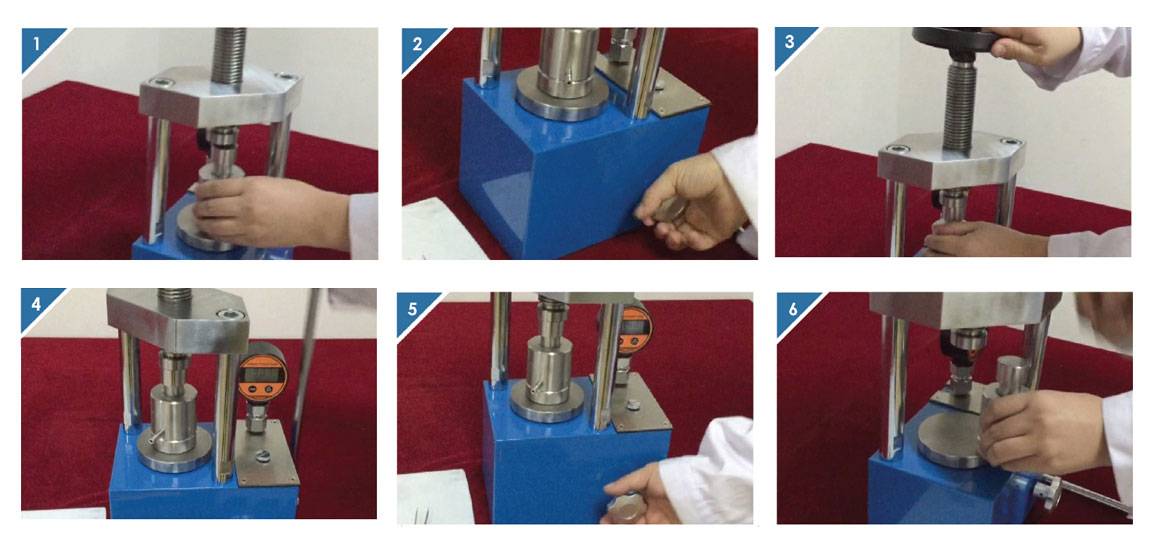
Applying Pressure
Once the sample is correctly positioned, slowly engage the hand pump to apply pressure. Monitor the pressure gauge closely to ensure the pressure does not exceed the recommended limits for the specific material being processed. Applying excessive pressure can lead to sample damage or equipment malfunction.
Maintain a steady and controlled pace when applying pressure. Rapid or uncontrolled pressure application can result in inaccurate compression results and potential safety hazards. If the press includes a manual control valve, use it to regulate the pressure application effectively.
Post-Operation Procedures
After the compression process is complete, carefully release the pressure by slowly operating the release valve. Ensure that all pressure is fully released before attempting to remove the sample from the press. Inspect the sample for any signs of damage or irregularities in the compression process.
Clean the press thoroughly, removing any debris or residue from the previous operation. Lubricate moving parts as needed to maintain smooth operation. Conduct a final inspection of the equipment to ensure it is ready for the next use.
Safety Precautions and Best Practices
Throughout the operation of a manual hydraulic press, safety should be the top priority. Always follow the manufacturer's guidelines and safety instructions. Operators should be trained and familiar with the specific model of the press they are using.
Regular maintenance and inspections are essential to prevent equipment failures and ensure safe operation. Keep a log of maintenance activities and any issues encountered during operations to track the equipment's condition over time.
In conclusion, operating a manual hydraulic press requires careful attention to detail and adherence to safety protocols. By following this step-by-step guide, operators can ensure efficient and safe processing of materials, contributing to the overall success of laboratory operations.
Maintenance and Troubleshooting of Manual Hydraulic Presses
Maintaining a manual hydraulic press is crucial for ensuring its longevity and optimal performance. Regular maintenance not only prevents unexpected breakdowns but also enhances the safety and efficiency of the equipment. This section provides a comprehensive guide on how to maintain a manual hydraulic press, including common issues and troubleshooting tips.

Regular Maintenance Practices
-
Cleaning and Lubrication: Regularly clean the press to remove any dirt, debris, or leaking oil that could affect its operation. Ensure all moving parts are properly lubricated to reduce friction and wear.
-
Inspect Hydraulic Fluids: Check the hydraulic fluid levels regularly and replace them as needed. Over time, hydraulic fluids degrade and can become less effective, leading to reduced performance and potential damage to the system.
-
Check Seals and Hoses: Inspect all seals and hoses for signs of wear or damage. Leaking seals or hoses can lead to loss of pressure and inefficient operation. Replace any damaged components promptly.
-
Vibration and Noise Levels: Monitor the press for any unusual vibrations or noises. These could indicate underlying issues such as misalignment or internal damage. Addressing these issues early can prevent more significant problems down the line.
Common Issues and Troubleshooting
-
Oil Leakage: Oil leakage is a common issue that can be caused by damaged seals, hoses, or fittings. To troubleshoot, first identify the source of the leak and then replace the damaged component.
-
Excessive Vibration: Excessive vibration can be caused by several factors, including misalignment, unbalanced loads, or internal damage. Check the alignment of the press and ensure the load is balanced. If the issue persists, consult a professional for a more detailed inspection.
-
Loud Noises: Loud noises during operation can indicate issues such as air in the hydraulic system, worn bearings, or damaged gears. Bleed the air from the system, and inspect and replace any worn or damaged components.
-
Pressure Fluctuations: Fluctuating pressure can be caused by air in the system, clogged filters, or issues with the pump. Check and clean the filters, bleed the air from the system, and inspect the pump for any issues.
Safety Considerations

Operating a manual hydraulic press requires adherence to strict safety protocols to prevent accidents and injuries. Always ensure that only authorized and trained personnel operate the press. Additionally, follow these safety guidelines:
- Clear the Area: Ensure the area around the press is clear of obstructions and personnel before starting any operation.
- Check Load Limits: Never exceed the maximum load limit of the press. Exceeding these limits can lead to equipment failure and potential injury.
- Emergency Stop: Familiarize yourself with the emergency stop procedure. In case of any issues, immediately stop the press and address the problem.
Advantages of Manual Hydraulic Presses
Manual hydraulic presses offer several advantages over their automatic counterparts, particularly in terms of cost and simplicity. They are typically lighter and have fewer parts, making them easier to maintain and operate. Additionally, manual presses do not require electronic controls, which can be a significant cost-saving factor for many laboratories.
In conclusion, maintaining and troubleshooting a manual hydraulic press involves regular inspections, proper cleaning and lubrication, and prompt replacement of damaged components. By following these practices and safety guidelines, you can ensure the longevity and optimal performance of your manual hydraulic press.
Comparison with Automatic Hydraulic Presses
When it comes to laboratory equipment, hydraulic presses are indispensable for various applications, particularly in materials testing and sample preparation. These presses come in two primary forms: manual and automatic. Each type has its unique advantages and limitations, making them suitable for different scenarios. This section delves into the detailed comparison between manual and automatic hydraulic presses, focusing on factors such as repeatability, accuracy, labor intensity, and overall cost.
Manual Hydraulic Presses
Manual hydraulic presses are often the go-to choice for laboratories due to their lower initial cost and simplicity. These presses operate without electronic components, relying solely on the physical effort of the operator to generate pressure. While this makes them economical, it also introduces variability in the applied pressure, as it depends on the strength and consistency of the person operating the press.

Advantages of Manual Hydraulic Presses
- Cost-Effectiveness: Manual presses are generally cheaper to purchase and maintain compared to their automatic counterparts. This makes them an attractive option for budget-conscious laboratories.
- Simplicity: With no electronic components, manual presses are straightforward to operate and maintain. They do not require complex setups or technical expertise for daily use.
Limitations of Manual Hydraulic Presses
- Labor Intensity: Operating a manual press is physically demanding. Repeated use can lead to fatigue, affecting the consistency and accuracy of the applied pressure.
- Inconsistent Pressure: The pressure applied in each cycle can vary significantly, depending on the operator's strength and technique. This lack of repeatability can be a major drawback in applications requiring precise and consistent pressure.
- Limited Applications: Manual presses are best suited for low-force, infrequent applications. They may not be practical for high-force or high-volume tasks.
Automatic Hydraulic Presses
Automatic hydraulic presses represent the next level of sophistication in laboratory presses. These machines use electric motors and sophisticated control systems to generate and apply pressure accurately and repeatably.
Advantages of Automatic Hydraulic Presses
- High Accuracy and Repeatability: Automatic presses can be programmed to apply a specific amount of pressure consistently, ensuring repeatable results. This is crucial for applications where precision is paramount.
- Efficiency: The use of electric motors and automated systems makes automatic presses more efficient, reducing the labor required and speeding up the process.
- Versatility: Automatic presses can handle a wider range of applications, including high-force and high-volume tasks, making them more versatile than manual presses.
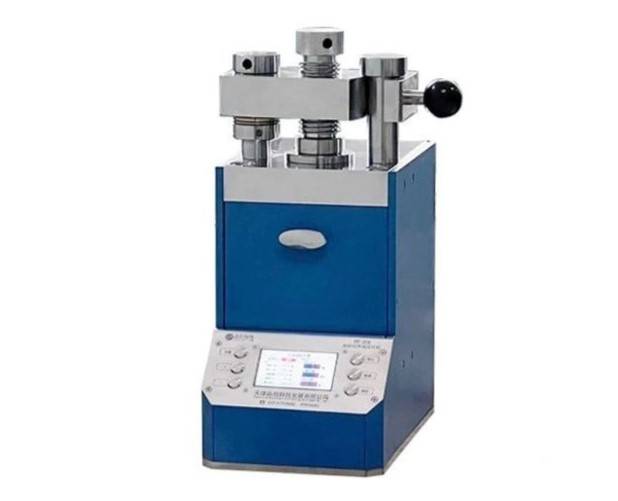
Limitations of Automatic Hydraulic Presses
- Higher Cost: Automatic presses are more expensive to purchase and maintain due to their advanced electronic components and control systems.
- Complexity: These presses require more technical expertise to operate and maintain, which can be a barrier for some laboratories.
Choosing Between Manual and Automatic Hydraulic Presses
The decision to opt for a manual or automatic hydraulic press depends on several factors:
- Application Requirements: For applications requiring high precision and repeatability, an automatic press is the better choice. Conversely, for low-force, infrequent applications, a manual press may suffice.
- Budget: The initial and ongoing costs are significant considerations. Manual presses are more economical, while automatic presses offer long-term efficiency and precision.
- Labor Availability: Consider the physical demands of operating a manual press. If frequent use is anticipated, the labor-intensive nature of manual presses may be a drawback.
- Volume and Consistency: High-volume tasks benefit from the efficiency and consistency of automatic presses. For low-volume tasks, manual presses can be more practical.
In conclusion, both manual and automatic hydraulic presses have their place in laboratory settings. By understanding the specific needs and constraints of your laboratory, you can make an informed decision that balances cost, efficiency, and precision. Whether you choose a manual press for its simplicity and affordability or an automatic press for its accuracy and efficiency, both options can contribute to successful laboratory operations.
Future Trends and Innovations in Manual Hydraulic Press Technology
The field of manual hydraulic press technology is poised for significant advancements, driven by the need for greater precision, efficiency, and integration with modern automation systems. As industries increasingly demand more sophisticated and reliable equipment, manual hydraulic presses are evolving to meet these challenges.
Integration of Automation
One of the most promising trends in manual hydraulic press technology is the integration of automation. Traditionally, manual hydraulic presses rely on human operators to control the application of force through hand-operated levers. However, the introduction of automated systems can significantly enhance the precision and consistency of these presses. For instance, servo-hydraulic technology allows for programmable motion, ultra-high precision, and energy savings, transforming manual presses into semi-automatic or fully automatic machines. This integration not only reduces the physical strain on operators but also ensures that the pressure applied is consistent across different tasks, thereby improving the quality of the output.
Advancements in Hydraulic Systems
Another area of innovation lies in the advancements of hydraulic systems themselves. Modern hydraulic presses are incorporating more efficient and environmentally friendly fluids, reducing the risk of leaks and improving overall system reliability. Additionally, the use of advanced materials in the construction of hydraulic components, such as high-strength alloys and composites, is leading to lighter and more durable presses. These materials not only enhance the performance of the press but also extend its operational life, reducing maintenance costs and downtime.
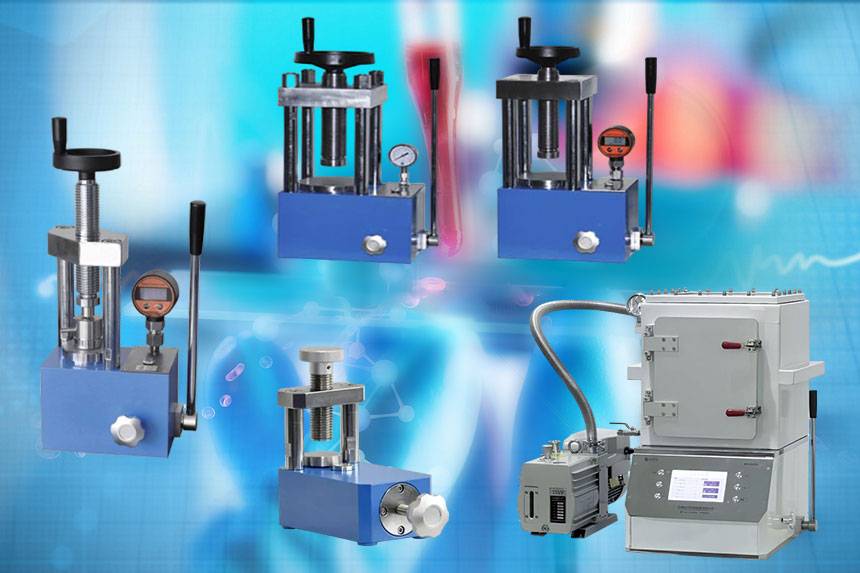
Miniaturization and Portability
The trend towards miniaturization and portability is also gaining traction in the hydraulic press industry. Hydraulic mini presses, for example, are designed to be compact and portable, making them ideal for use in laboratories and other settings where space is at a premium. These mini presses utilize hydraulic power to produce force, offering the same level of precision and control as their larger counterparts but in a more convenient and accessible package. This development opens up new possibilities for applications in research and development, quality control, and small-scale manufacturing.
Energy Efficiency and Sustainability
Energy efficiency and sustainability are becoming increasingly important considerations in the design and operation of hydraulic presses. Innovations in hydraulic system design are focusing on reducing energy consumption and minimizing environmental impact. For instance, the use of variable displacement pumps and energy recovery systems can significantly lower the energy requirements of hydraulic presses. Additionally, the adoption of renewable energy sources to power these presses is another avenue being explored to make them more sustainable.
Conclusion
In conclusion, the future of manual hydraulic press technology is bright, with numerous innovations on the horizon. The integration of automation, advancements in hydraulic systems, miniaturization, and a focus on energy efficiency and sustainability are all driving forces behind these developments. As these trends continue to evolve, manual hydraulic presses will become more precise, reliable, and adaptable, meeting the growing demands of various industries and applications. The potential for these innovations to enhance productivity, reduce costs, and improve environmental stewardship makes them an exciting area of exploration for manufacturers and users alike.
Related Products
- Laboratory Manual Hydraulic Pellet Press for Lab Use
- Laboratory Manual Hydraulic Pellet Press for Lab Use
- Hydraulic Diaphragm Lab Filter Press for Laboratory Filtration
- Manual Cold Isostatic Pressing Machine CIP Pellet Press
- 24T 30T 60T Heated Hydraulic Press Machine with Heated Plates for Laboratory Hot Press
Related Articles
- Hydraulic Tablet Press: Comprehensive Guide to Design, Operation, and Applications
- Manual Hydraulic Pellet Press: An Efficient Tool for Spectral Analyses Preparation
- Automatic Hydraulic Press: The Ultimate Guide for Efficient Sample Preparation and Industrial Processes
- Manual Pellet Press: A Comprehensive Guide to Efficient Lab Pelletizing
- Understanding Hydraulic Pellet Press: Working Mechanism and Applications
